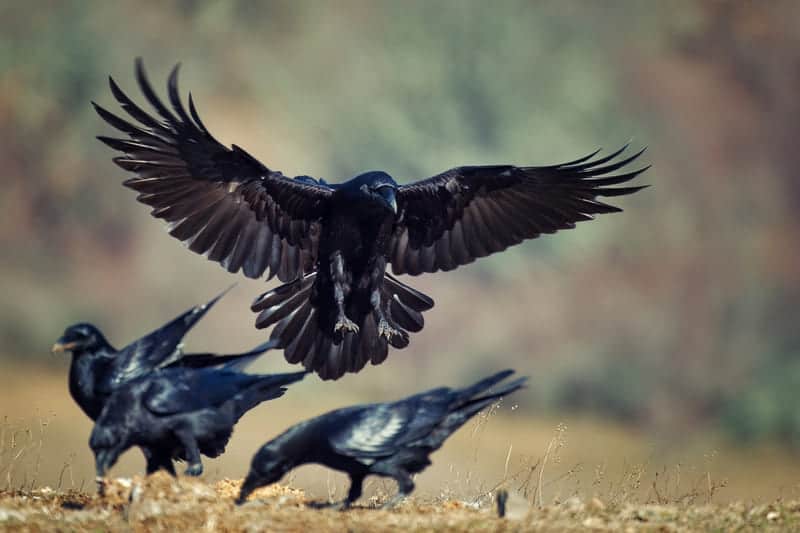When you are going to work, grocery stores, or just to hang out in the park, you can often see these large blackbirds.
If you look at them closely, you can see that there are two types of these birds – they look alike but are still different, and you are not mistaken!
These are two bird cousins – ravens and crows, but they are different. Stay with us and find out what draws them apart.
So similar, but at the same time so different. Where should we look for those differences between these birds?
For starters, ravens can weigh up to 4 times more than a crow. Its peak is larger, and the feathers on the neck are a little shaggy.
Another way to make a distinction between the two is by looking at them when flying – a crow’s tail is shaped like a diamond, while the tail of a crow looks like a fan.
There are some behavioral details to look out for.
Ravens usually fly in pairs, while crows keep themselves in groups. Their communication is also different. Crows are signaling each other with loud cawing, and the raven’s vocalization is more like a throating croaking.
One thing that sets them together is their intelligence.
Crows and ravens are among the smartest animals in the world. Their intelligence sometimes resembles humans. They are so smart that they can recognize a human. If you did something wrong to them, be sure that they will remember you.
Ravens know the concept of storing and guarding their food, while crows often use their numbers to their advantage. They are not afraid to attack a larger and more dangerous foe if their larger numbers are enough to make a difference.
Crow vs Raven: Comparison Chart
| Traits | Crow | Raven |
| Intelligence | Very intelligent. Can recognize human faces. | Can pre-plan a task. Communicate with each other with 7 different sounds. Little smarter than a crow. |
| Sound | Loud cawing | Croaking from the throat |
| Appearance | Black, tail in the shape of a diamond | Black, tail in the shape of a wedge. Feathers on the neck tend to be a little longer |
| Size | 40 – 53 cm (16 – 21 inch) | Up to 66 cm (26 inches) |
Now you know what sets these birds apart, and what marks them as close relatives, but if you want to learn some interesting facts, stay with us. The fun just began!
FAQs
Are ravens and crows the same?
They both belong in the corvid family of birds, but they are not the same.
Yes, they are closely related, but once you learn their differences, you will be able to tell them apart easily. They differ in appearance, size, and intelligence.
Which is more aggressive, a crow or a raven?
Crows are very territorial creatures and they can often attack other animals and even humans if their nests are in danger. They gather in flocks and then attack with their claws and beaks, using sheer numbers to their advantage.
Ravens are also territorial birds, and sometimes they will attack humans if their territory or nests are threatened. When comparing these birds, crows are more aggressive, and they even attack ravens if food or territory is contested.
Can crows and ravens mate?
For different animals to be able to mate, they need to be closely related. Crows and ravens are, but sometimes they don`t get along.
Ravens usually attack crow’s nests to eat their eggs, and that`s why crows are often aggressive towards ravens. These are some of the reasons why they cannot breed.
But, there were a couple of recorded cases where it happened, so this is no easy answer. They can mate, but it must be a group of special circumstances.
What is the difference between blackbirds, and crows, and ravens?
A common blackbird is not related to crows and ravens.
There are several major differences, and we will note here just a couple of them. They are significantly smaller than both of them: their size is between 23 and 29 cm (9 ¼ – 11 ½ inches).
Blackbirds are singing birds when compared to the loud cawing and croaking of the ravens and crows. Both ravens and crows have large black beaks, while blackbirds have smaller yellow beaks.
Is it possible to befriend a crow?
Yes, but you need to be patient. Start by offering crow meals. They love dried food, nuts, and eggs – they love it. After you managed to gain crow’s trust, start feeding it regularly.
The next step is providing water. And try to conduct this process in a quiet and safe environment.
Can a raven be a good pet?
It is hard to keep a raven as a pet because it requires a lot of attention. When they are in captivity they demand a lot of attention, and the owner will have a full-time job keeping a raven.
What symbolizes a raven?
In some parts of the world, ravens are connected with death, while in others they are treated as bringers of good luck.
In the Bible, ravens are considered evil beasts, because they didn`t embark on the ark, and they kept feeding on the corpses of the dead.
Raven is also connected with dreams – making a dream catcher out of the raven feathers will help stop bad dreams.
Interesting Facts About Crows And Ravens
Raven fact 1: They join up with other animals to find food. There was a couple of reported cases where ravens worked together with wolves on finding and catching prey. Ravens saw a suitable target for the wolves from the sky, and then guided the wolves to hunt and catch the prey. After the successful hunt, birds and wolves shared the meal. Amazing!
Raven fact 2: Ravens can produce up to 100 different vocal signals. They can talk, sing, and even imitate sounds made by humans and other animals.
Crow fact 1: Crows respect their dead. When a crow dies, sometimes other crows from the same flock gather around and make a crow funeral. No, they don`t bury their fallen, but stand around it, cawing loudly. It is their way of paying last respects.
Crow fact 2: Crows sometimes help their family. In some cases, crows help their parents in feeding and protecting their younger siblings. Sometimes, this help lasts for 5 years!
Crows And Ravens in The Game Of Thrones
Ravens are an important part of the animal kingdom in Games of Thrones. These majestic birds are respected as very intelligent creatures. They are used to deliver important messages between kingdoms. Some of them are even trained to talk simple human sentences, like parrots.
They are not important or regarded much like the ravens but crows are also frequently mentioned in the Game of Thrones universe. They are mentioned as corpse eaters, and after the battles, they are seen having a feast on the fallen warriors. From there comes the term “Feast for the crows”.
Summary
From this article, you learned that crows and ravens are interesting and intelligent creatures, cousins, but still very different.
They are often used in different magical worlds, as Game of Thrones, and they are always close to humans. Like we have a special connection. Magnificent creatures, altogether!
If you like what you read, stay with us, because we are always adding new material with interesting topics for you to read!



